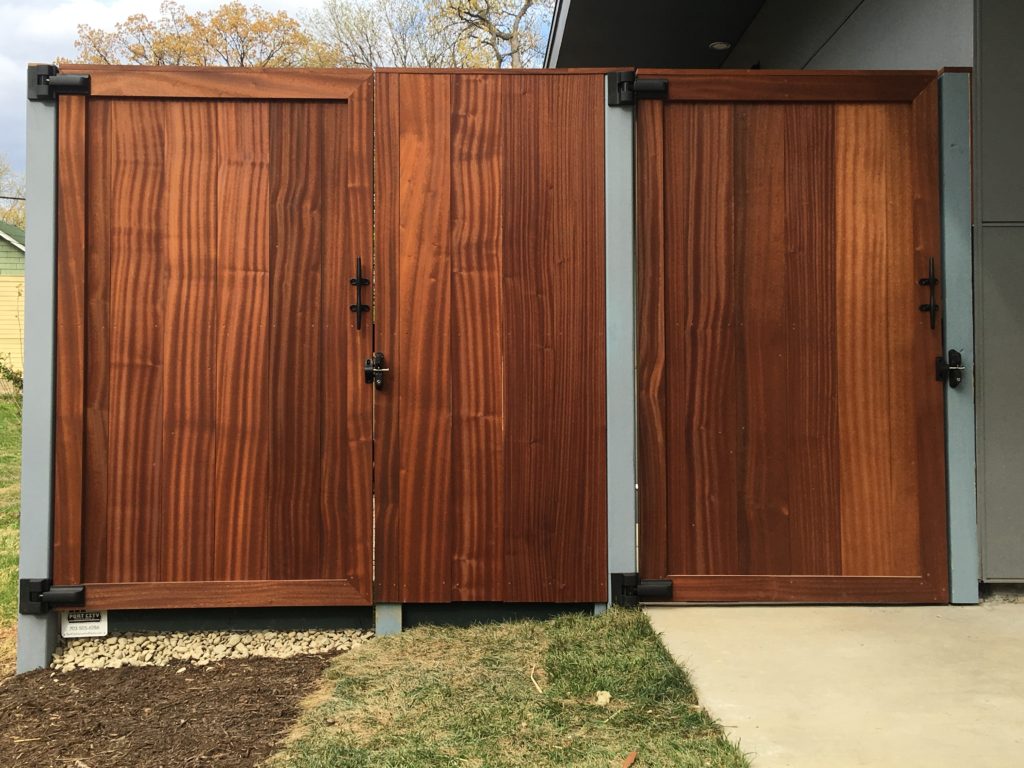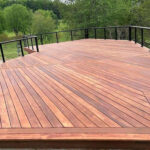Even for an experienced woodworker or finisher, oil-based and water-based finishes can easily feel like two different worlds. Whether you’re a homeowner planning to spruce up your new deck or a contractor looking for the best finish for your project, understanding the differences between these two types of finishes is essential. In the following sections, we will explore the characteristics and benefits of water-based finishes as well as oil-based finishes. We’ll discuss the factors you should consider when choosing a finish and compare their performance in exterior applications. Additionally, we’ll provide some helpful tips for caring for exterior finishes.
Wood finish basics
There are hundreds of different finishes to choose from, but let’s break it down into 2 categories to make it easier. We’ll be examining film finishes that form a protective layer on top of the wood as well as penetrating finishes that soak into the wood. They both protect the wood: film from the outside, and penetrating from the inside. There are some hybrid ideas out there now where you have a film finish that is quite thin that will penetrate deeper on the initial coats and flow more easily making for a slower build up of the film; these hybrids are usually generically termed “wiping varnish.” However, EVERYTHING can be grouped into these 2 main groups despite the numerous features and benefits the manufacturers will cite.

Film Finishes
Think of a bartop coating as one extreme or the finish on your hardwood floors. These are film finishes that form a very hard layer on top of the wood. Some absorption occurs during the first coat, but the goal is to build up the thickness of that film as subsequent coats are applied. Polyurethanes, lacquers, shellacs, and most forms of “varnish” are all film finishes. Each will have different hardnesses as well as more or less solids that provide UV resistance. Durability is provided by the strength of that outer film and the fact that it physically blocks the wood. However, for long term exposure, water always wins, and it will eventually get underneath the film finish and cause peeling, flaking and cracking. For most film finishes, to reapply them you have to sand the initial film finish away and start over. The quality of the finish and the wood species underneath will determine how long before the finish fails, but a film finish will always fail against Mother Nature.
Penetrating Finishes

Furniture oils and decking oils are good examples here. Simply put, the finish is applied and left alone while it soaks into the wood. What doesn’t soak in is wiped away. As the finish dries, it hardens, protecting the wood from the inside out. But “harden” is a bit misleading, as it will not be nearly as hard as a film forming finish. These finishes can be thought more of moisturizing and stabilizing from the inside out. They will not resist dents and scratches like a film finish, but they also will not flake and peel in an exterior application. A drawback to this is that you really can’t build up a film even with more and more coats, which makes it hard to get any kind of sheen. Moreover, when maintenance is required, simply wipe on another coat without having the need to sand away the old finish.
Finish vs Solvent
The finish itself can be a variety of things from Acrylics and plastics to natural resins, and it is delivered (borne) on a solvent which could be water, alcohol, organic compounds like toluene and methanol, or any variety of oils both natural and engineered. These solvents hold the actual finish in solution to allow us to brush, spray, or wipe it on. As the finish dries, the solvent flashes off, leaving behind the finish and any pigments included in the finish. Chemical reactions occur to cross link and cure the finish at this point to provide the durability, water resistance, or UV resistance – depending on the type of finish being used. This is THE MOST IMPORTANT part to know. The actual finish is what is left behind AFTER the solvent has evaporated.
Myth #1: Use Oil Based Finishes Outside, Because Oil and Water Don’t Mix
It’s easy to assume that oil based finishes will naturally repel water for years to come; however, in reality, once fully cured there is not oil left in the finish.
Understanding Water-Based Finishes

Water-based finishes are a popular choice for exterior surfaces due to their unique characteristics and benefits. With improvements made in recent years, water-based finishes are becoming the go-to choice for ease of use and beautiful results. Understanding how these finishes work, as well as their advantages and limitations, can help you make an informed decision when it comes to protecting and enhancing your exterior wood.
Water-based finishes, as the name suggests, are primarily composed of water. They contain a lower amount of volatile organic compounds (VOCs) compared to traditional oil-based finishes, making them environmentally friendly, safer to use, and more accepted in regions with tighter regulations. These finishes rely on water as a carrier for the resins and other components that provide protection and durability.
One of the key advantages of water-based finishes is their quick drying time. Unlike oil-based finishes, water-based finishes dry rapidly, allowing for faster application and multiple coats in a shorter span of time. Most manufacturers will tell you that you can apply subsequent coats in 30 minutes. (Although we have all pushed that inside 10 minutes in practice….sssshhh!)
In addition to their fast drying time, water-based finishes offer excellent color retention and UV resistance. The compounds used in water based finishes will not yellow over time and impart color. Often these are referred to as “water white” finishes. They have the ability to retain their original color for a longer period, even when exposed to harsh sunlight. The low odor makes them ideal for interior applications, but this UV resistance and non yellowing nature makes them ideal as well for exterior applications where color fading is a concern.
Myth # 2 Water Based Finishes Don’t Allow the Finish to Penetrate as Deeply as Oil Based
In the early days of water based finishes, this might have been the case. The dry time was significantly faster, and the evaporation caused the finish to become more viscous, slowing its absorption. The compounds that could be borne on water were larger molecule sizes, and they just didn’t soak in as quickly. Today, advances in finish chemistry allow for smaller particle sizes for better absorption but also for the finish to stay active longer using the natural capillary action of the wood to absorb just as deeply as an oil based finish.
Exploring Oil-Based Finishes
When it comes to exterior finishes, choosing the right type is crucial to ensure long-lasting protection and aesthetics for your project. Oil-based finishes, as the name suggests, are formulated with oils— either organic or inorganic. These finishes are known for their durability and rich depth of luster in the appearance. Oil based finishes….or really the finish borne on the oil are comprised of compounds that achieve a more natural sheen. Unlike water-based finishes that rely on water as a carrier, oil-based finishes use solvents to deliver the protective and decorative elements to the surface.
One of the key benefits of oil-based finishes is their ability to penetrate deep into the wood fibers, because they dry very slowly with a long working time. This deep penetration creates a deep luster that enhances the wood’s natural beauty as well as providing excellent protection against moisture, preventing cracking and rot. Additionally, oil-based finishes can offer great UV resistance, protecting the wood from sun damage and fading due to higher solid contents suspended in the oil which reflect sunlight. However, these resins will yellow with UV exposure. Less yellowing oil based finishes are available, but they use different compounds which will not be as durable and can cost substantially more.
Oil-based finishes often are more volatile and have a strong odor. Unlike water-based finishes, oil-based finishes are not very eco-friendly. In areas with regulations regarding VOCs, some oil-based options may not be able to be used at all. The solvents used in traditional oil-based finishes can emit strong odors and require proper ventilation during application. The drying time for oil-based finishes is longer compared to water-based alternatives, which may affect project timelines. Additionally, oil-based finishes tend to darken over time, altering the original color of the wood.
There are also some drawbacks to consider when you’re choosing between organic and inorganic oil-based finishes. Organic oils, when paired with heat and moisture in an exterior application, create the perfect home for mold to grow. Inorganic oils mitigate this issue; however these finishes are much more costly.
Factors to Consider When Choosing a Finish
When it comes to choosing an exterior finish for your project, there are several important factors to consider. Understanding these factors will help you make an informed decision that meets your specific needs and preferences. Here are three key considerations to keep in mind:
Durability and Longevity: One of the primary concerns when selecting a finish is its durability and longevity. You want a finish that can withstand the elements and protect your surfaces for an extended period of time. Both water and oil-based finishes provide great protection against moisture, UV rays, and other environmental factors. Regardless of oil vs water, you want a penetrating finish to protect wood more from moisture over time while being easy to repair and maintain. In other words, all finishes outside will fade and even fail. Plan for the failure with a finish that is easy to refresh. Assess the climate and conditions in which your project will be exposed to in order to determine the level of durability and longevity required.
Application and Maintenance: Another factor to consider is the ease of application and maintenance. Water-based finishes will dry faster, which is an important factor for your project if you’re finishing on-site. They also often require less cleanup time. On the other hand, traditional oil-based finishes may require more careful application and longer drying times. And don’t forget, oil based finishes heat up when they dry. Always spread out your oily rags on the concrete to dry. Balled up rags in a pile WILL catch fire and burn hot. We have seen holes burned straight through an Ipe deck, which is a class A fire rated species!

Appearance and Aesthetics: The final factor to consider is the desired appearance and aesthetic of your project. Water-based finishes are offered in a wide variety of colors and opacities. Be sure to consider the opacity, especially if you want the grain pattern of your substrate to show through. If you have a specific final color in mind, consider it prior to even choosing your wood species, if possible, as the color of the wood itself paired with a tinted semi-transparent water-based finish can create an entirely unique shade. Oil-based finishes, on the other hand, tend to provide a richer and deeper color, enhancing the wood grain and offering a more traditional look. You’ll typically find that oil-based finishes are offered in natural wood tones rather than the brighter colors you may find in water-based options. Be sure to consider the overall style of your project to determine which finish will complement it best.
Caring for Exterior Finishes
Plan for failure!
After applying the finish, it is important to properly care for and maintain it to ensure its longevity. Typical best practice would be to check annually for signs of wear to determine if refinishing is needed. With most traditional finishes – water and oil-based – it’s necessary to sand back the finish to start with a smooth surface when it’s time for refinishing. There are many different methods for refinishing based on the finish originally used—brushes, rollers, or sprayers are typical choices.
The major benefit of our Alpha Pre-Finished Cladding products is the ability to refinish without sanding. We know you’ll love the look of your project when it’s first installed, but what happens when it’s exposed to harsh weather conditions over time? The very nature of the finishes we chose for our lines results in no flaking or cracking, just a smooth finish that slowly and evenly wears over time. A fresh coat right on top of the existing finish is all it needs to maintain its exceptional beauty and durability.

Improvements on Oil finishes

Oil-based finishes seem to have a lot of cons associated with them in order to get the rich color and protection in the final result. Luckily, improvements have been made over the years to achieve the same benefits while improving upon the drawbacks. Cutek, the hybrid oil-water finish we often use here at J. Gibson McIlvain Co., does not require that same level of meticulous application as traditional oil-based. Whether it is rolled, sprayed, or brushed, this product self-levels and absorbs completely into the wood, acting not only as a barrier to moisture but also as a wood stabilizer. Its ability to absorb deep into the substrate is unmatched, but unlike water-based, it does not fully cure which means the oil does not evaporate away and as a result maintains that water barrier. This can be seen as a great positive, though, as smudging can be easily wiped away with a damp cloth. As it is made with an inorganic oil, it prevents mold growth in the wood over time, extending the life of your exterior wood in yet another way.
Water vs Oil Based Finishes?
It’s clear as paint that both water and oil-based finishes have their place. Personally, we are partial to water-based as we want to show off the wood underneath and provide a low VOC, interior and exterior finishing option. But, especially with the improvements made to oil-based as seen in the Cutek brand, we heavily use certain oil-based finishes for decking and cladding products that will face extreme conditions.
The bottom line is that for exterior uses, the best finish for your particular project could be either of them. The choice is dependent on the climate and sun exposure, as well as desired aesthetics. No matter which option you choose, the wood experts at J. Gibson McIlvain Co. are ready to help you achieve your desired look. Our factory finishing capabilities allow you to add finish onto your order ahead of time, completely removing the stress of finishing on the job site. We’d love to introduce you to our Alpha products and custom finishing capabilities.
Which finishes do you find to be easier to use? Which do you find is more often desired for aesthetics? Reply below to tell us your thoughts!









The Ipe i sourced from mcilvain for my deck has always been treated with ipe oil as recommended by shannon rogers. are you telling me that there are better water based coatings available for ipe?
thank you, and Happy easter!
kevin
Universal truth it seems is that there is always a “better” option with the pace with which finishing science is changing. From a pure decking perspective I think Cutek is the best product out there now. It is oil based but as stated in this article, it is an inorganic oil. But more importantly the stabilizing nature of the product is so different from everything else out there.